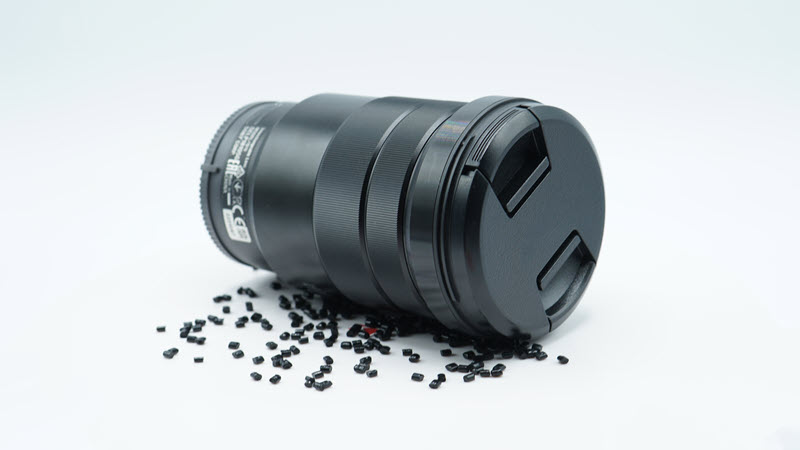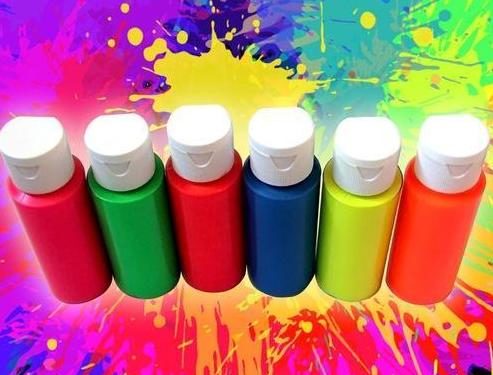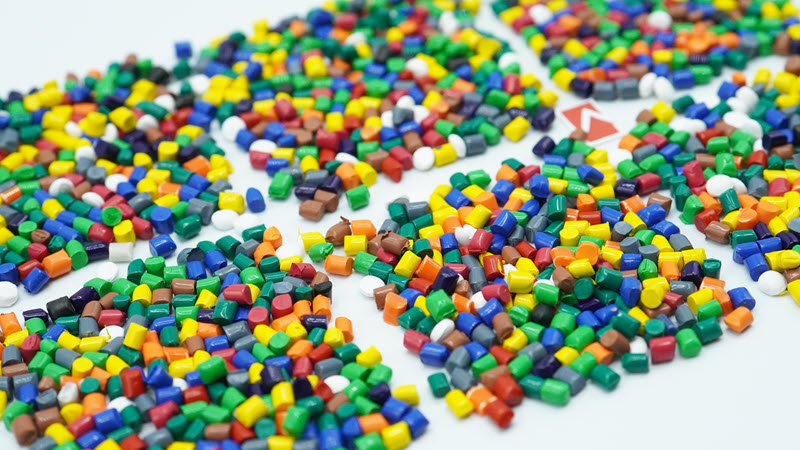It has been almost a century since the first plastic was invented by an American named Baekeland, now plastic products appear in all areas of daily life, and still maintain a significant growth rate. No other material has ever experienced such a miraculous experience in the history of human industrial development. In addition, the invention and use of plastic are recognized as one of the crucial innovations of the 20th century, which influenced human development. Products made from virgin plastic cannot attract customers' attention because they are colorless or have a natural white color. So coloring them is an important thing.
Related:
- Injection molding color mixing problems and solutions
- Plastic Colorant Suppliers - 30+ Companies Found
- What makes color concentrates for plastics faded and how to prevent it?
I. What is plastic?
Although it only appeared a hundred years, plastic is the most commonly developed and applied material of mankind. This dizzying development is mainly based on its excellent usability performance. Basically, plastic is a synthetic or semi-synthetic material, created from petroleum. Plastic is easy to process and is applied in methods such as injection molding, extrusion, blowing film,...
II. Plastic properties
Some salient features of plastic can be mentioned as follows:
Flexibility
The raw material for plastic production is petroleum, which can be supplied in large quantities, so the cost of producing plastic is low. We can drastically reduce the production cost of plastic products with their thermoplasticity, although the cost of oil is not cheap.
Plasticity is the ability to form a new shape after being cooled that was previously softened by heat. This can produce products with complex shapes, are easy to manufacture, and have much higher machining efficiency than metal. A large number of inventions and innovations in plastic-forming processes have been introduced over the past 100 years, especially injection molding, which can produce products with complex shapes.
Low density
With the development of the industry of plastic, wood, steel, fabric, shoes, and a variety of other traditional materials, many PO resins have a density of less than 1g/cm3. For example, PE and PP can float on water. The density of plastic foam is only about 0.1g/cm3. The density of some resins is heavier. For example, PVC is 1.4g/cm3, and PTFE is 2.2g/cm3 but they are still lighter than metal and ceramic.
Although the density of plastics is low, their strength is great, as nylon is 1/10th the density of steel but their flexural strength is half. The hardness of plastics is not that of metal, compared with metal and ceramic they have lightweight, good mechanical properties, high mechanical strength, and wear resistance. So they can make products that are light in weight but have good durability. Now a part of plastic is used to make most of the car parts, about 50% of the car's material, so the mass of the car is reduced to one-third. The lighter weight of the car will result in less energy consumption.
Anti-corrosion
Corrosion resistance is an important issue that needs to be addressed. Every year in China, the direct economic loss by corrosion is at least 20 billion yuan. Most plastics are resistant to corrosion. They are strong and do not react with acids or alkalis, so they are often used in chemical preparation. Plastics do not rust or rot in wet environments, nor are they corroded by microorganisms. so they are often used as doors, and windows for buildings, shops, etc.
Very good insulation properties
The molecular chain of the plastic is a combination of atoms by covalent bonds, neither an ionic nor a donor bond in the structure, its resistance should be up to 10^14 ~10^ 16. Therefore, plastic has a very good insulating ability, and can be used as a switch button or household electrical appliances, insulating sheaths for wires and cables. It is also widely used in the field of electricity, electronics, radar, television, telecommunications, multimedia, computers, etc.
One very important thing to know is the disadvantages of plastic: poor heat resistance, deformation at high temperatures, burning, and oxidation under the influence of light, oxygen, heat, water, and humid environment. In addition, their low surface hardness makes plastic products easily damaged. As an insulator, plastic is prone to static electricity and dust absorption.
The main disadvantage of plastic is that it does not decompose, which is extremely harmful to the environment. It does not decompose even if it is buried for hundreds of years. With the pace of life accelerating, in response to society's demand for convenience and health, disposable food boxes, bubble bags, and other products are blooming in daily life. Although their convenience and low cost bring many benefits to human life, they pose many potential hazards to the ecosystem and the environment if they are accidentally released into the environment. This phenomenon is known as white pollution.
III. Plastic applications

Possessing excellent properties, plastic can be used to create a variety of products, as soft as silk, as hard as iron, and as transparent as glass. Nowadays plastic products are present in all areas of life. It is not an exaggeration to say that without plastic there is no life. The main applications are listed below:
- Structural materials
- Insulating materials
- Building materials
- Materials used to contain
- Consumer goods
- Wire cover, electrical panel, electrical parts
- Plastic pipes, gas pipes
- Ball bag, imitation cloth bag, plastic box,
- Utensils, stationery, toys
- Transport tools, vehicle parts
- Fabrics, carpets, lawns
IV. Types of plastic
There are more than 300 types of plastic produced around the world, the classification method is quite complex and different, but they can overlap. For convenience, we classify them by physical properties, application properties, and processing methods.
1. Based on physical properties
Based on physical properties, plastics can be divided into two types, thermosetting plastics, and thermoplastics. Thermoplastics have a linear or branched molecular structure, which softens by high temperatures and hardens on cooling, and this process can be repeated many times. So scrap, or waste in the processing process can be recycled by crushing them. Thermoplastics include: PE, PP, PVC, PS, ABS, PA, PO, PC, PMMA etc.
Thermosetting resins have plasticity and linear structure before being heated, the linear polymer chains can be combined by chemical bonds to form a bonding network when heated. It cannot be melted or dissolved anymore and its structure cannot be changed again. Thus both chemical and physical transformations occurred in the process. Waste and other things left in the process cannot be reused.
2. Based on processing method
Plastics can be classified by processing methods such as molded plastic, injection molded plastic, and blown plastic.
3. Based on finished products
Plastic can be divided into plastic film, plastic pipe, cable sheath, building material, and plastic foam.
V. How to color plastic
Tinting is the process of changing the color of an object or giving color to an object that has no color. Color is represented by the selective absorption and reflection of certain colored light waves, which by convention can be classified into pigments and dyes.
Dyes are synthetic organic substances that are soluble in most solvents and other dyes. The dye has good clarity, strong tinting ability, and small density. Unlike dyes, pigments are not soluble in water, oil, or plastic, and are usually only dispersed in the resin and impart color to the object. In addition, it does not react with the material being tinted, the pigment can only be uniformly dispersed in the resin by physical methods to achieve ideal tinting performance. Despite such a difference, it is still not possible to give a definition for them with certainty. The classification of pigments is not clear. Some inorganic pigments are soluble in certain polymers. For example, red 254 (DDP red) is a magenta color that is insoluble in most polymers.
Dyes are organic color masterbatchs whereas pigments can be inorganic or organic. They differ in nature. Inorganic pigments are salts or oxides of metals. Inorganic pigments of the same kind have a lot in common. They are insoluble in common solvents and are more heat resistant than organic pigments, on the other hand, organic colors are usually more intense.
In a nutshell, the colors used for plastics include organic pigments, inorganic pigments, and dyes.
Industrial pigments

Industrial pigments are the original state of the pigment. Its specific surface area is large and it tends to agglomerate, it is very dusty, has problems with automation, and does not disperse completely during coloration. It does not affect the properties of the tinted product and is cheap. The current yield of powdered color is about 12% of the total pigment for plastic. Although it has many limitations, it is easy to process and easy to formulate for many colors, especially with a small number of products with many different colors. Unlike color beads, it is not limited by base resin type and color. So it is widely used in small and medium plastic manufacturing companies. Need to be precise when measuring industrial pigments otherwise it will be very easy to get the wrong color. Therefore, to minimize errors, it is necessary to use electronic scales as accurately as possible.
Colorant looks like sand grains
Pigment has a granular structure, which is prepared by attaching a large amount of pigment to a resin carrier. The concentration of this material is usually 20 ~ 40% for organic and 50 ~ 70% for inorganic. The colorant is completely dispersed in the carrier during granulation. So it disperses very well when tinting, has less dust, is environmentally friendly, has less pollution, is easy to mix, accurate weighing, high production efficiency, good product expression, reduced the number of materials in the production process, increases the shelf life of stored materials, easy to process, etc.
The ratio of resin to be mixed is about 1:50. It is now widely used in the production of membranes, electrical cables, roofing sheets, pipes, and synthetic fibers. It is the main method for coloring plastics and the amount used accounts for more than 60%. However, pigments are often expensive because the preparation process is complicated and expensive, another disadvantage is the deterioration of plastic quality due to incompatibility when different polymers are mixed together, so the quality of the resin is reduced. The carrier of the pigment and the resin base of the product to be tinted should be the same.
Liquid pigment

The concentration of dyes and pigments is 20-60% in liquid pigments. The feature of this product is that it can be measured with a small tube, which will reduce equipment investment costs compared to automatic measuring mixers. This product category applies to some types such as PET. It accounts for only about 2% of the total modulation methods. The structure of liquid color is quite similar to color beads. One advantage of liquid color is that it wets the pellets very well before extrusion, this is especially important with clear pastels or shades, which is the most important advantage of liquid pigments over granular colors. Another benefit is that it maximizes color luster, due to the complete dispersion of color, easy weighing, no dirt, and reasonable price.
Color masterbatch

Color masterbatch is a multi-colored component prepared by melting, mixing, and extrusion. After mixing primary resin with other additives. It can be used in many direct processing methods, especially in thermoplastics, moreover, the composite has very good color distribution and stable quality. So it is widely used in the tinting of home appliances and auto vehicle components, which have strict requirements for tinting quality. Composite beads are expensive because the amount of color to be mixed is already used in the tinting resin. It is an effective tinting method in the field of modified plastics, engineering plastics, composite resins, high-grade plastics, etc.
Different methods for different resins need to be mixed.
|
Plastic
|
Colorant
|
|
LLPE
|
Color masterbatch 80%
|
|
LDPE, Polyolefin
|
Pigment 4%
|
|
PP, PVC cứng
|
Pigment
|
|
PVC, PVC mềm
|
Liquid pigment
|
|
ABS, PC
|
Color masterbatch 21%
|
|
GPPS, HIPS, Poly styrene
|
Color masterbatch
|
|
PET
|
Color masterbatch 2%
|